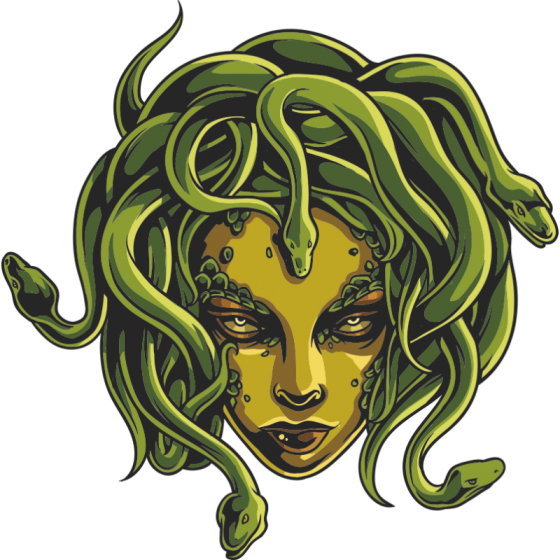Medusa & Gorgons

Medusa was one of the three Gorgons, daughters of Phorcys and Ceto, sisters of the Graeae, Echidna, and Ladon – all dreadful and fearsome beasts. A beautiful mortal, Medusa was the exception in the family, until she incurred the wrath of Athena, either due to her boastfulness or because of an ill-fated love affair with Poseidon. Transformed into a vicious monster with snakes for hair, she was killed by Perseus, who afterward used her still potent head as a weapon, before gifting it to Athena.
Medusa’s Sisters and Birth
Gorgon Medusa
Medusa – whose name probably comes from the Ancient Greek word for “guardian” – was one of the three Gorgons, daughters of the sea gods Phorcys and Ceto, and sisters of the Graeae, Echidna, and Ladon.
From then on, similarly to Euryale and Stheno, her older Gorgon sisters, Medusa was depicted with bronze hands and wings of gold. Poets claimed that she had a great boar-like tusk and tongue lolling between her fanged teeth. Writhing snakes were entwining her head in place of hair. Her face was so hideous and her gaze so piercing that the mere sight of her was sufficient to turn a man to stone.
Medusa and Poseidon
It wasn’t always like that. Medusa – the only mortal among the Gorgon sisters – was also distinguished from them by the fact that she alone was born with a beautiful face. Ovid especially praises the glory of her hair, “most wonderful of all her charms.” The great sea god Poseidon seems to have shared this admiration, for once he couldn’t resist the temptation and impregnated Medusa in a temple of Athena. Enraged, the virgin goddess transformed Medusa’s enchanting hair into a coil of serpents, turning the youngest Gorgon into the monster we described above.
Perseus and Medusa
Soon after this, trying to get rid of Perseus, Polydectes, the king of Seriphos, sent the great hero on a quest which he believed must be his final one. “Fetch me the head of Medusa,” commanded Polydectes. With the help of Athena and Hermes, and after compelling the Graeae for Medusa’s whereabouts, Perseus finally reached the fabled land of the Gorgons, located either in the far west, beyond the outer Ocean, or in the midst of it, on the rocky island of Sarpedon. Medusa was asleep and Perseus, using the reflection in Athena’s bronze shield as a guide (so as to not look directly at the Gorgons and be turned into stone), managed to cut off her head with his sickle.
The Miraculous Head of Medusa
Now that Perseus had Medusa’s head in his bag, he went back to Seriphos. However, while flying over Libya, drops of Medusa’s blood fell to the ground and instantly turned into snakes; it is because of this that, to this day, Libya abounds with serpents. When Perseus arrived in Seriphos, he used Medusa’s head to turn Polydectes and the vicious islanders into stones; the island was well-known long after for its numerous rocks.